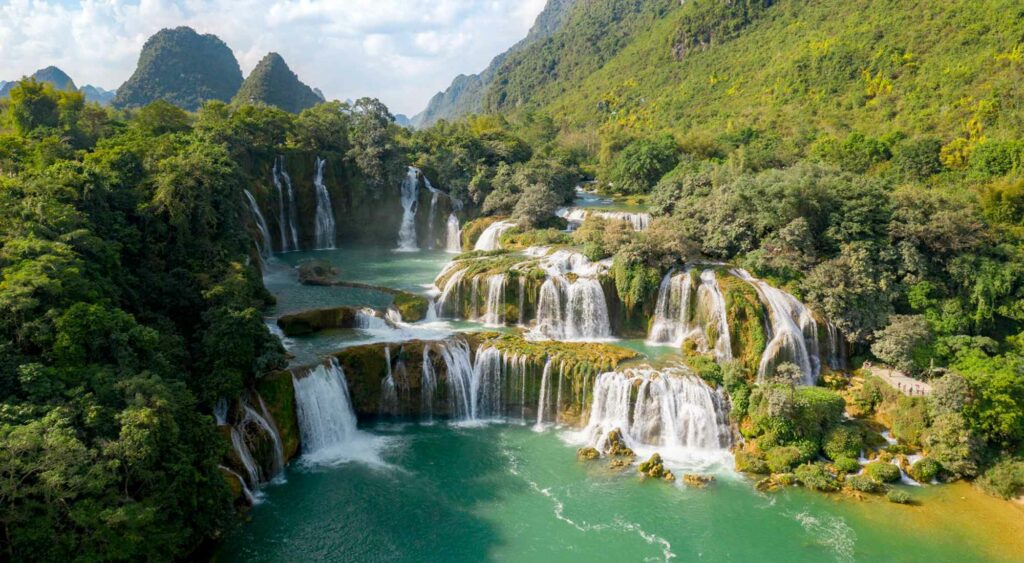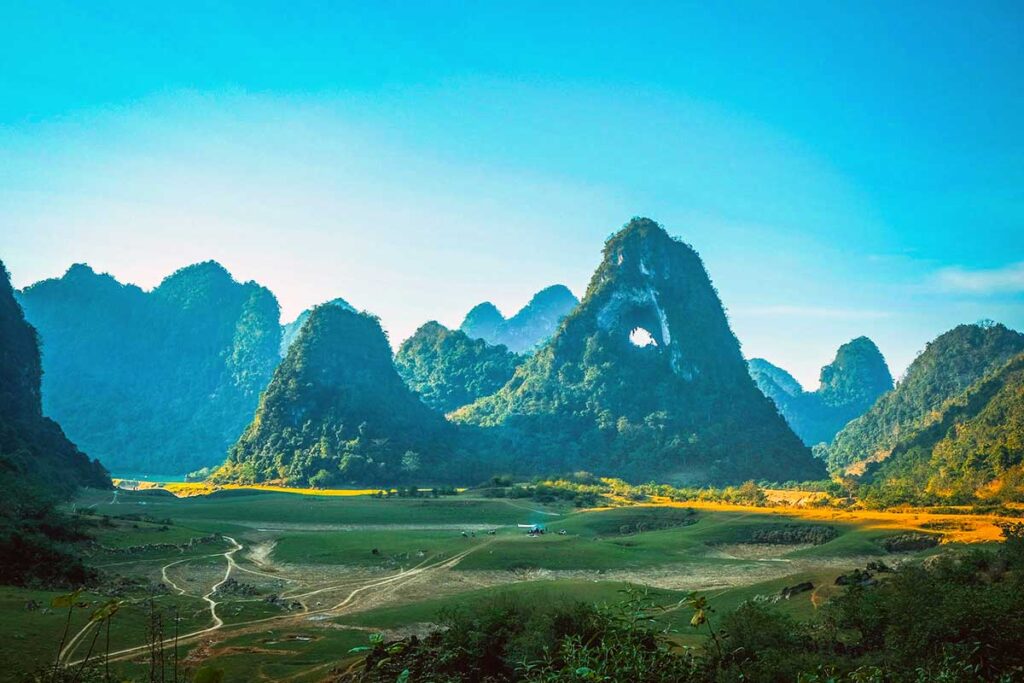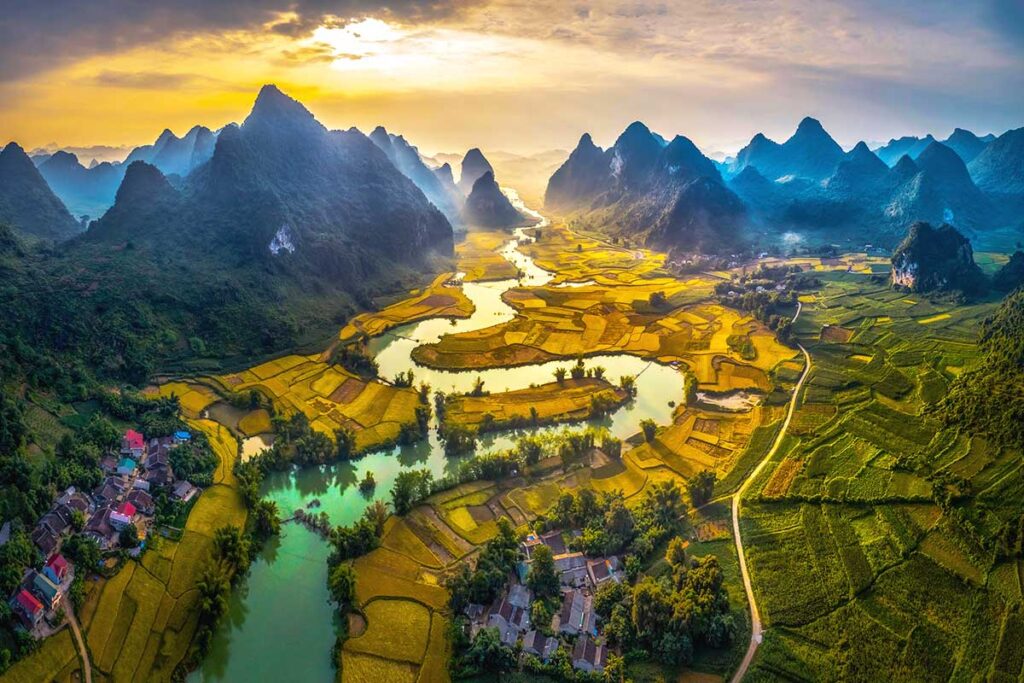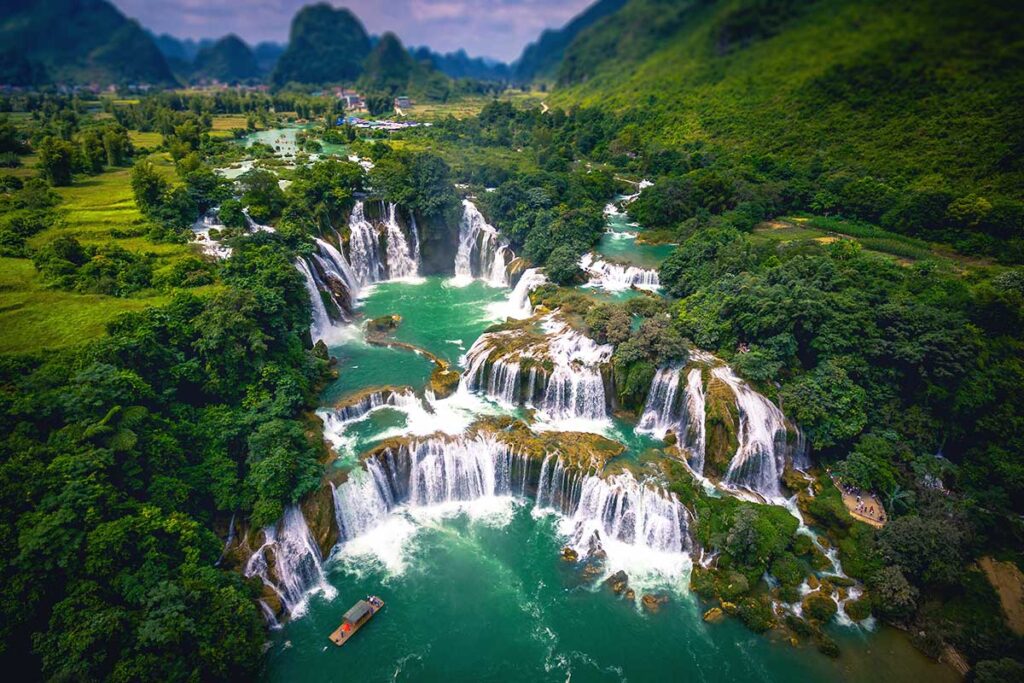Ban Gioc Waterfall – Vietnam’s most impressive waterfall
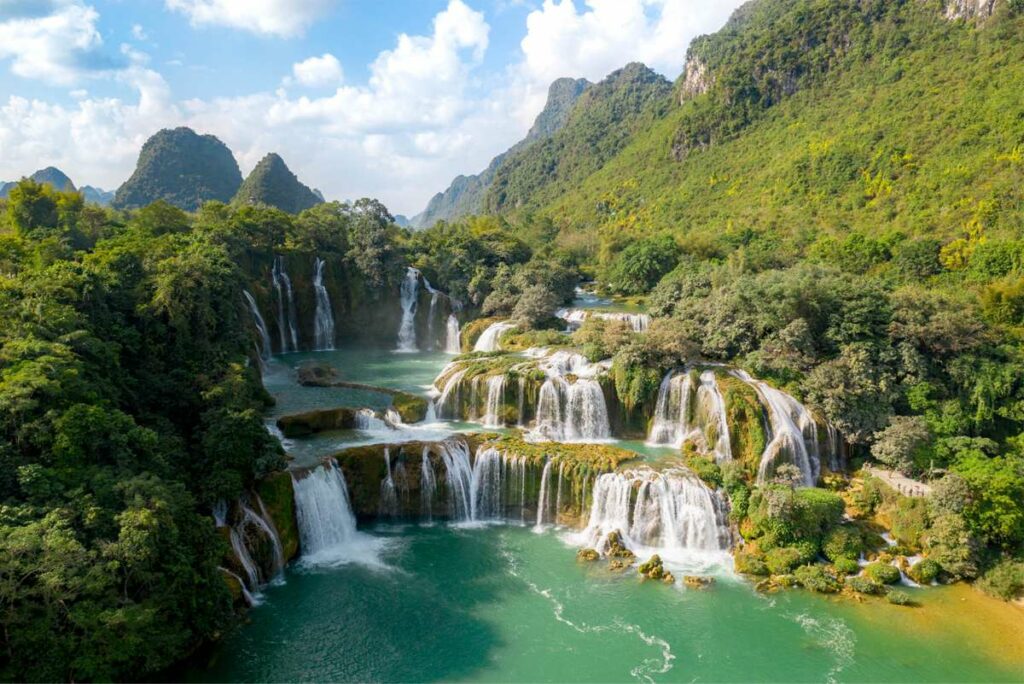
Ban Gioc Waterfall (Thác Bản Giốc in Vietnamese) is located in northern Vietnam’s Cao Bang province, right on the border with China. It’s fed by the Quay Son River, which originates in China and flows through the limestone landscapes of both countries.
The waterfall itself is made up of three main levels, with a total height of around 30 meters. What makes Ban Gioc especially unique is its width — over 300 meters — making it the widest waterfall in Vietnam. Its broad, layered structure creates multiple cascades that tumble over rock ledges and green vegetation, especially impressive during the rainy season when the flow is at its peak.
Despite gaining attention on social media in recent years, Ban Gioc remains relatively quiet compared to other destinations in Vietnam. It’s still far enough off the main tourist route to feel peaceful.
Practical info for visiting Ban Gioc Waterfall
Everything you need to know before your visit — from entrance fees to parking and opening hours.
Where is Ban Gioc Waterfall?
Ban Gioc Waterfall is located in Trung Khanh District, in the northeastern province of Cao Bang, right on the border with China. The falls are part of the Quay Son River, which flows from China into Vietnam. Around 8 hours from Hanoi.
Tip: Want to know how to get there? Jump to Getting There.
Opening times
Ban Gioc Waterfall is open daily from 7:30 AM to 5:00 PM. Because it’s a ticketed site, it’s not accessible outside of these hours.
Entrance fee
- Entrance: 45,000 VND (approx. 2 USD)
- Bamboo raft ride (optional): 50,000 VND (approx. 2 USD) for a 10-minute trip
Tickets are sold at a small kiosk just before the entrance gate. Bring cash — cards are not accepted.
Parking
- Motorbike parking: 10,000 VND (approx. 0.40 USD)
There’s a large parking lot near the entrance. If you’re on a guided tour, your driver will take care of it. If you’re riding solo, a parking guard will collect the fee and give you a ticket.
Tours to Ban Gioc Waterfall:
What to see and expect
Here’s what to expect during your visit, from arrival to viewpoints and optional activities.
1. Parking and entrance
The drive from Cao Bang city to Ban Gioc takes just under 2 hours. As you arrive, you’ll see a large parking area on the hillside. If you’re on a tour, your guide or driver will handle this. Otherwise, park your motorbike and pay the parking fee to the nearby guard.
From the parking area, you’ll walk downhill toward the entrance gate — and you’ll already get your first views of the falls. Tickets are checked at the gate, so have your cash ready. Just inside, you’ll find a few basic food and drink stalls.
2. Views of the Ban Gioc Waterfall
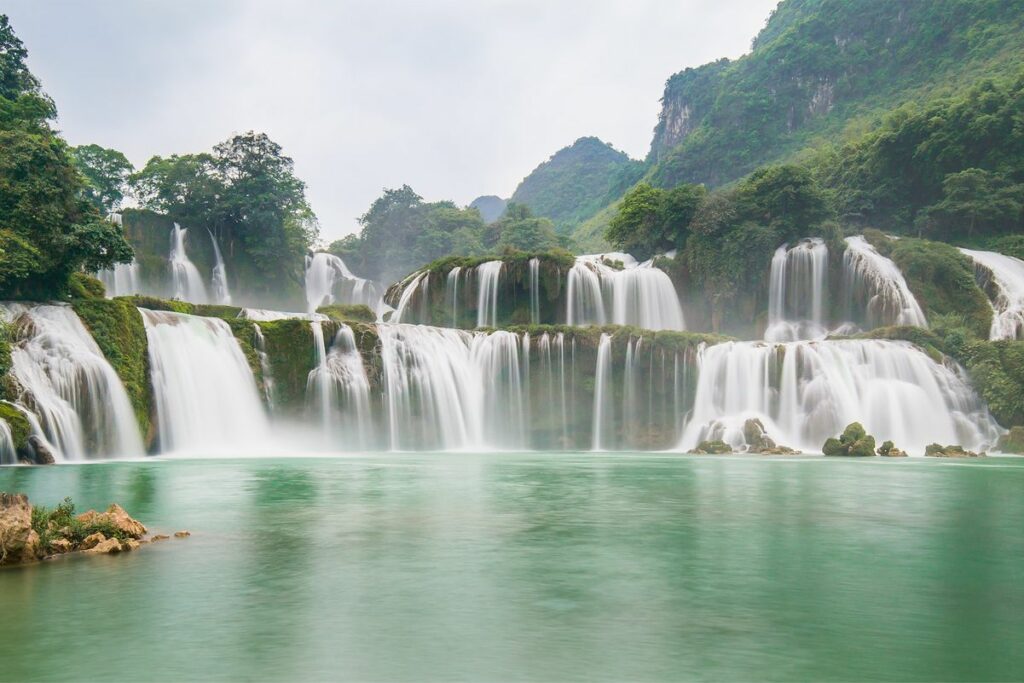
Once inside, gravel paths and wooden bridges lead you closer to the falls. There are actually two waterfalls here: the larger, dramatic main falls, and a “smaller” side waterfall that’s still massive — but only visible from the Vietnamese side. On the Chinese side, this second waterfall isn’t accessible.
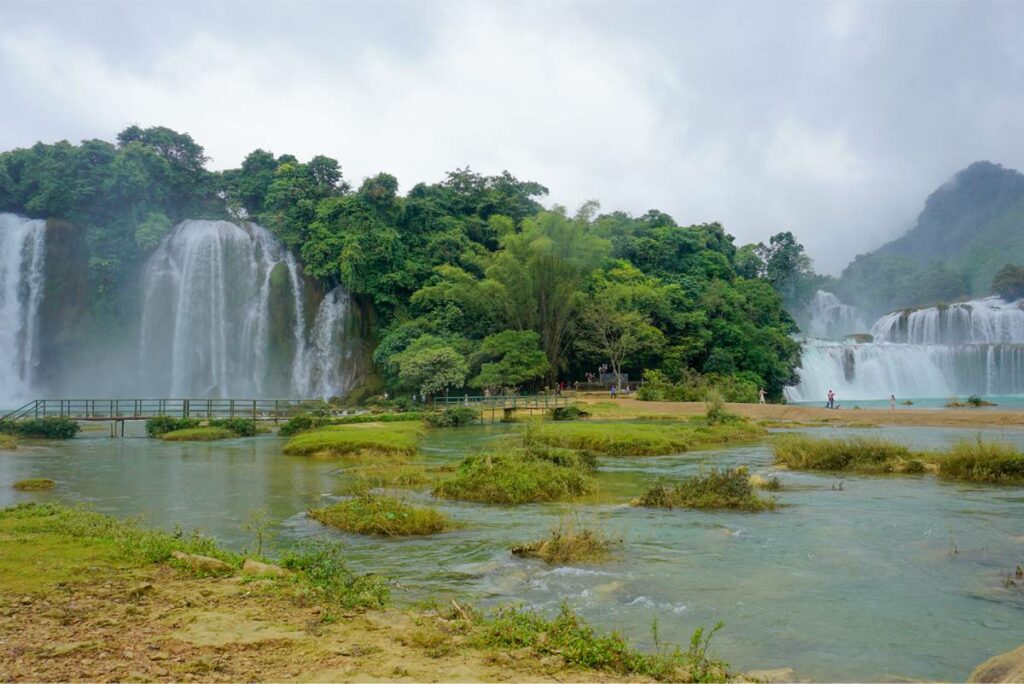
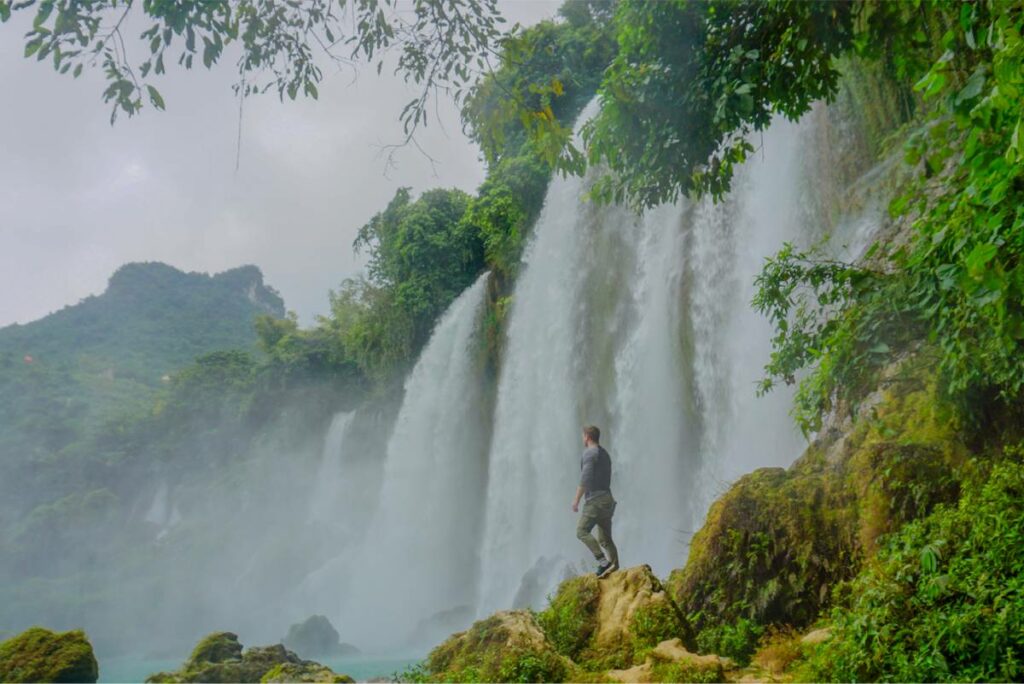
The setting is very open, with grassy banks and plenty of space to walk and take photos. For those feeling adventurous, there’s a “secret” trail that climbs up through the jungle toward the middle level of the falls. It starts after the wooden bridge near the base of the main waterfall. This path is unofficial, steep, and partially blocked — so it’s not recommended for everyone and is done at your own risk.
3. Bamboo raft ride (Optional)
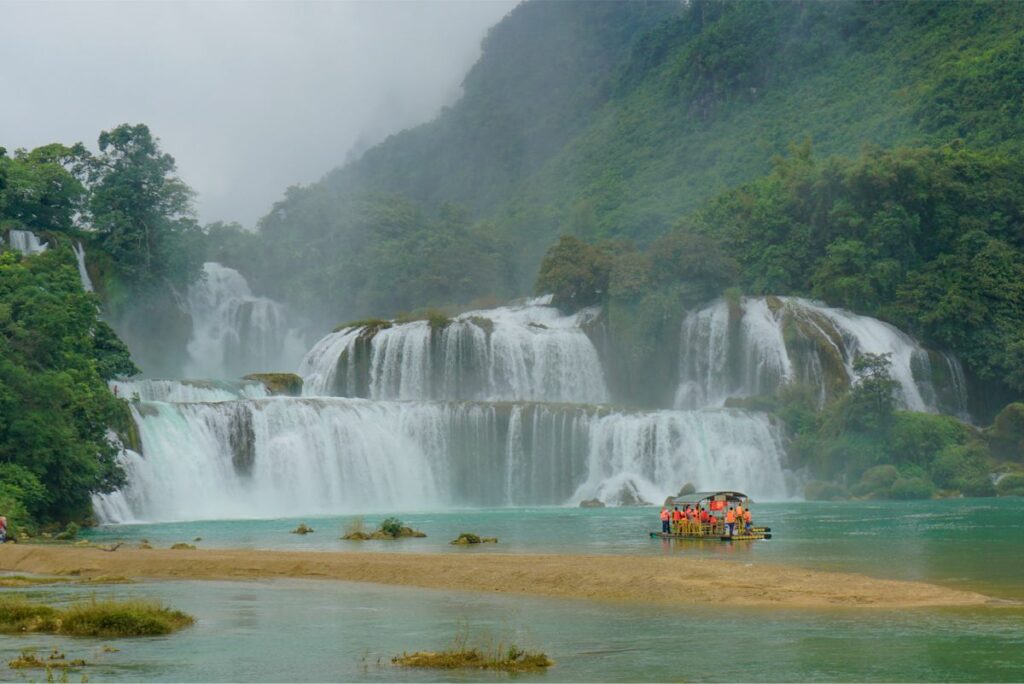
You can take a bamboo raft for a closer view of the waterfall, right along the border with China. The ride lasts about 10 minutes and costs 50,000 VND (~2 USD). It gets you right up to the spray zone, which is great for photos — but expect to get a little wet. While it’s not a must-do, it’s a fun add-on if you want to feel the power of the falls up close.
Best time to visit Ban Gioc Waterfall
Yes — Ban Gioc Waterfall has a best time to visit. Like most waterfalls in Vietnam, it depends heavily on rainfall. In the rainy season, the falls are powerful and wide. In the dry season, the flow slows and can become much smaller. You can visit all year round — there’s always water — but your experience will vary depending on the time of year.
Rainy Season (May to September)
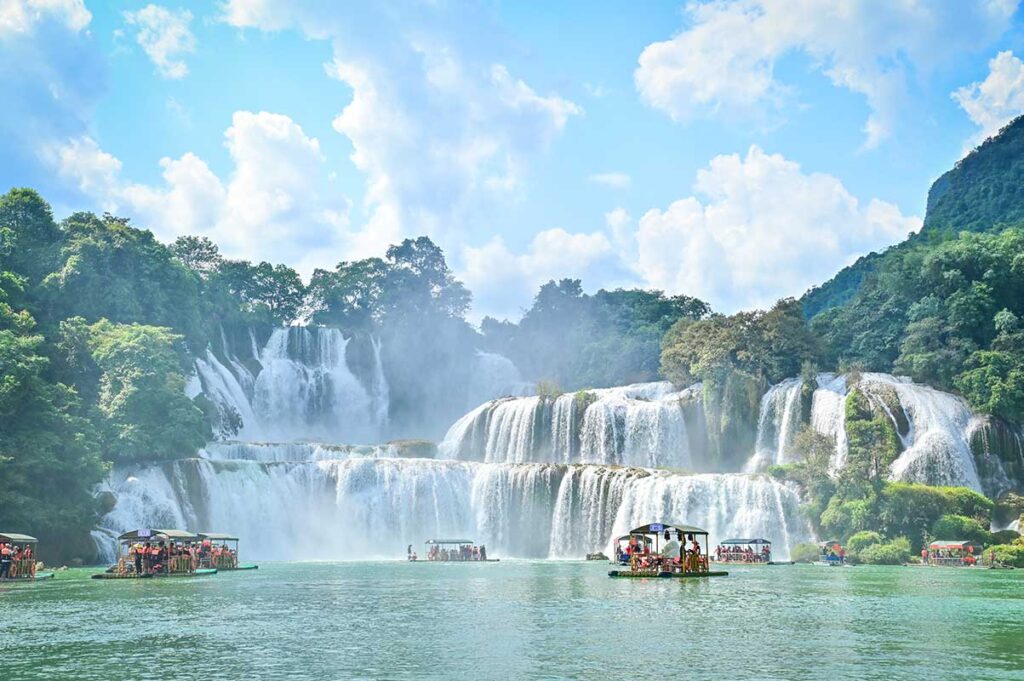
This is when Ban Gioc is at its most powerful. Even by late May or early June, the falls start to swell again after the dry months. Throughout the rainy season, the waterfall grows in size, sometimes dramatically — a few days each year, it can even overflow parts of the viewing area (though this is rare). The only downside: early in the rainy season, the water may appear muddy brown due to runoff. Later in the season, especially by August and September, the flow remains strong but the water turns a clearer, more photogenic blue-green.
Dry Season (October to April)
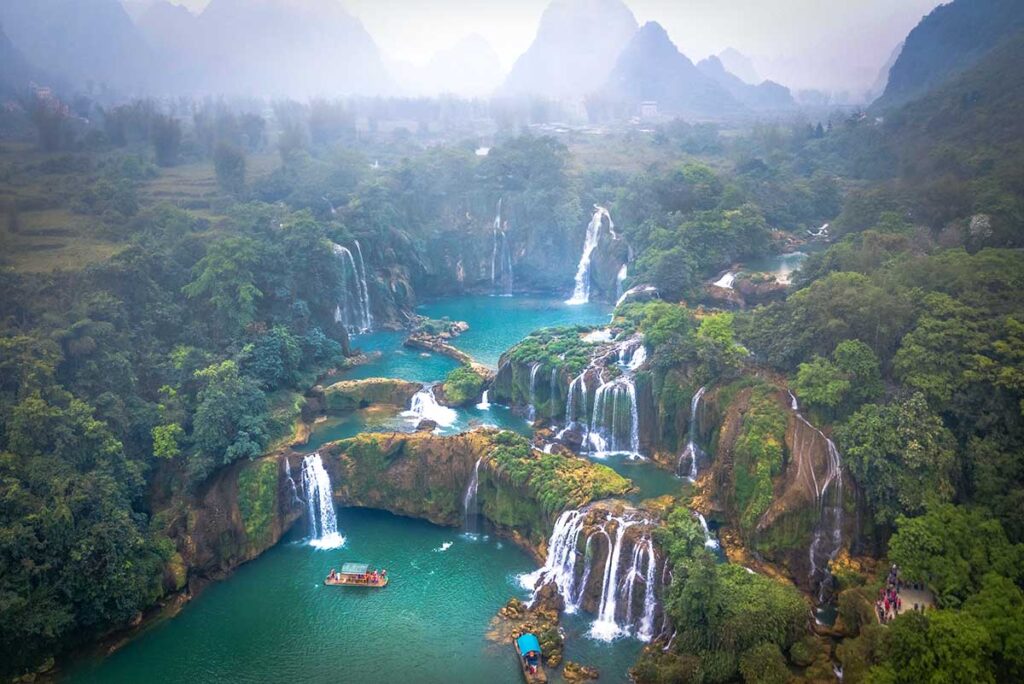
Early in the dry season (October to December), the waterfall can still look impressive — and the water often takes on a beautiful turquoise color. But the longer the dry season goes on, the lower the flow becomes. From February to April, Ban Gioc may still have a stream flowing, but it loses much of its scale and intensity. It’s still worth visiting, especially for the peaceful scenery, but don’t expect the full dramatic version.
Ban Gioc Waterfall at its best: August to October
This is the ideal time — the water is high, the color is clearer, and the weather is beginning to stabilize. It’s also rice harvest season in the surrounding valleys, adding to the landscape.
Want to dive deeper? See our full month-by-month guide to the Best time to visit Ban Gioc Waterfall.
Tips for visiting Ban Gioc Waterfall
Here are a few practical tips to help you make the most of your visit to Vietnam’s most impressive waterfall.
Bring a waterproof jacket (and phone case)
If you plan to take the bamboo raft ride, expect to get sprayed — especially when the water is high. A light waterproof jacket and a waterproof phone case will go a long way to keeping you (and your camera) dry.
Bring cash
There are no ATMs near Ban Gioc and card payments aren’t accepted. You’ll need cash for the entrance fee, bamboo raft ride, parking, and any food or drinks you might want at the local stalls or restaurants nearby.
Avoiding the crowds
Ban Gioc is never as crowded as places like Ha Long Bay, but it can still get busier on Vietnamese public holidays and weekends. Weekdays are the quietest. If you’re visiting on a weekend or busy day, try to arrive early in the morning — most group tours arrive later, so you’ll enjoy a more peaceful experience.
Combine with other sights nearby
Ban Gioc is remote — around 8 hours from Hanoi — so it’s worth seeing more than just the waterfall. There are other stunning spots nearby like valleys, villages, and caves that can easily fill a day or two. Don’t rush in and out just for the falls — this whole area is worth your time.
Wear good shoes
The area around the waterfall includes gravel paths, rocky trails, and grassy sections that can get slippery or muddy, especially after rain. Sturdy walking shoes or sandals with grip will make your visit more comfortable and safer.
5 Highlights around Ban Gioc Waterfall
With a distance of more than 300 km from Hanoi and over 7 hours of driving, it can be a bit far for only visiting the waterfall. Luckily there are plenty of stunning thing to do in Cao Bang. Here are a 5 not too far from the Ban Gioc Waterfall.
1. Ban Gioc Temple
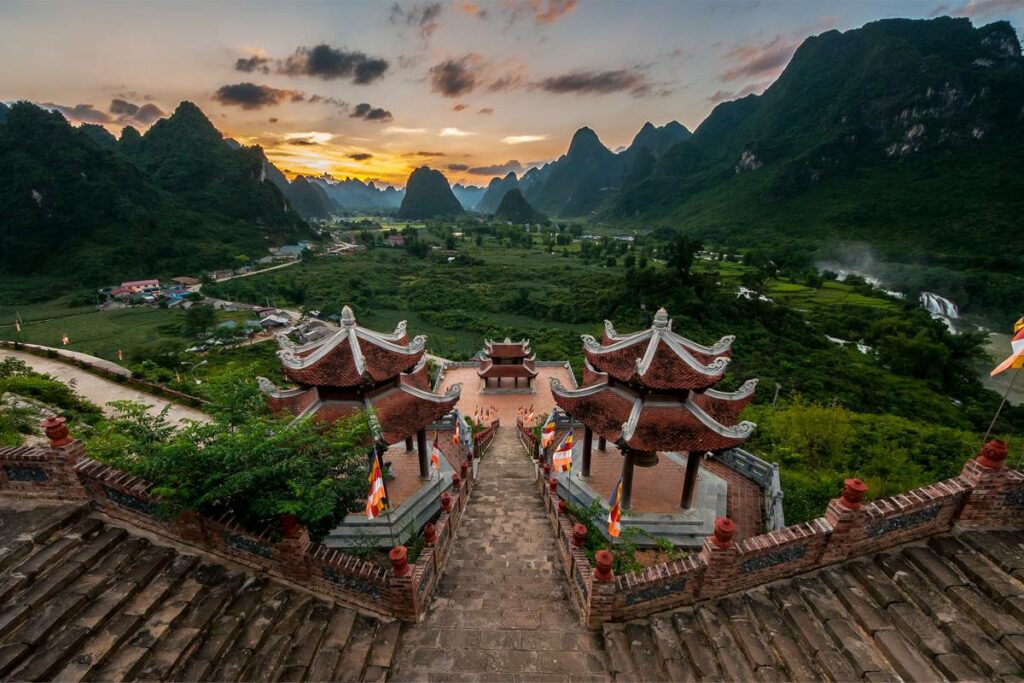
When you have explored Ban Gioc you can go to the best viewpoint of the waterfall. You can find this view from the Truc Lam Phat Tich pagoda, also known as the Ban Gioc temple. From the waterfall you go back to the main road and follow it about 600 m back towards Cao Bang until you come to a turn to the left with a few souvenir and food stalls. This is the access road to the Truc Lam pagoda, also called the Ban Gioc temple. When you reach the top, you will be rewarded with a breathtaking panorama that looks straight down into the valley and the Ban Gioc waterfall.
2. Nguom Ngao cave
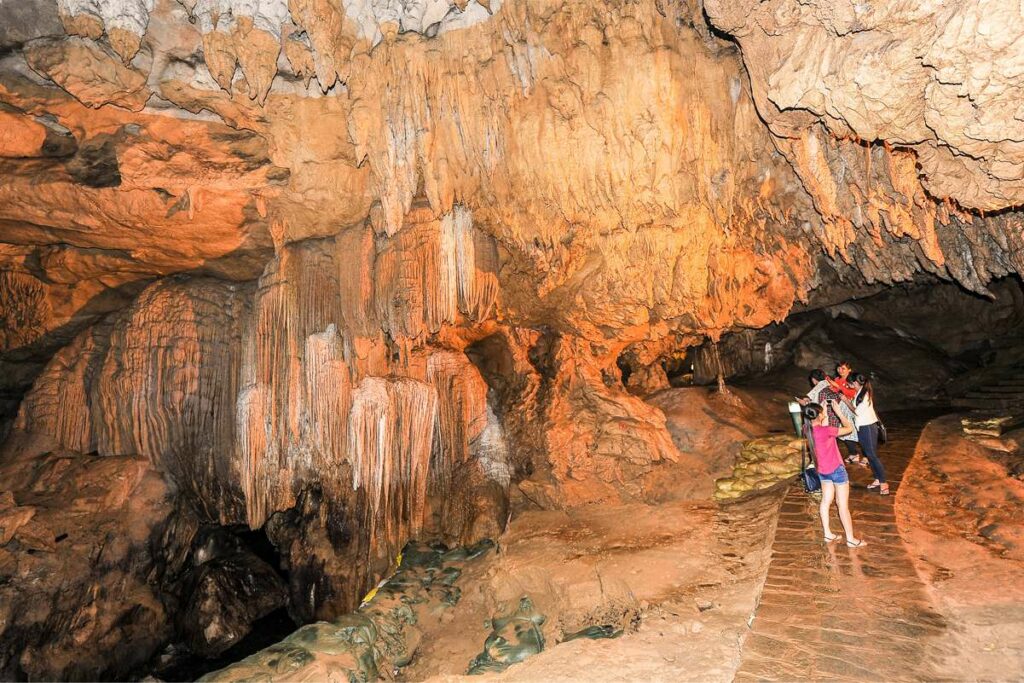
At only three kilometers from the Ban Gioc waterfall you will find the impressive limestone Nguom Ngao cave. With a total length of more than 2,100 meters, it is an ideal place for cave lovers. You can walk through a large part of the cave that is beautifully lit and very impressive. The cave is remarkable, thanks in part to the water dripping through the limestone walls, but this can also ensure that the path can sometimes be very slippery.
3. Phong Nam valley
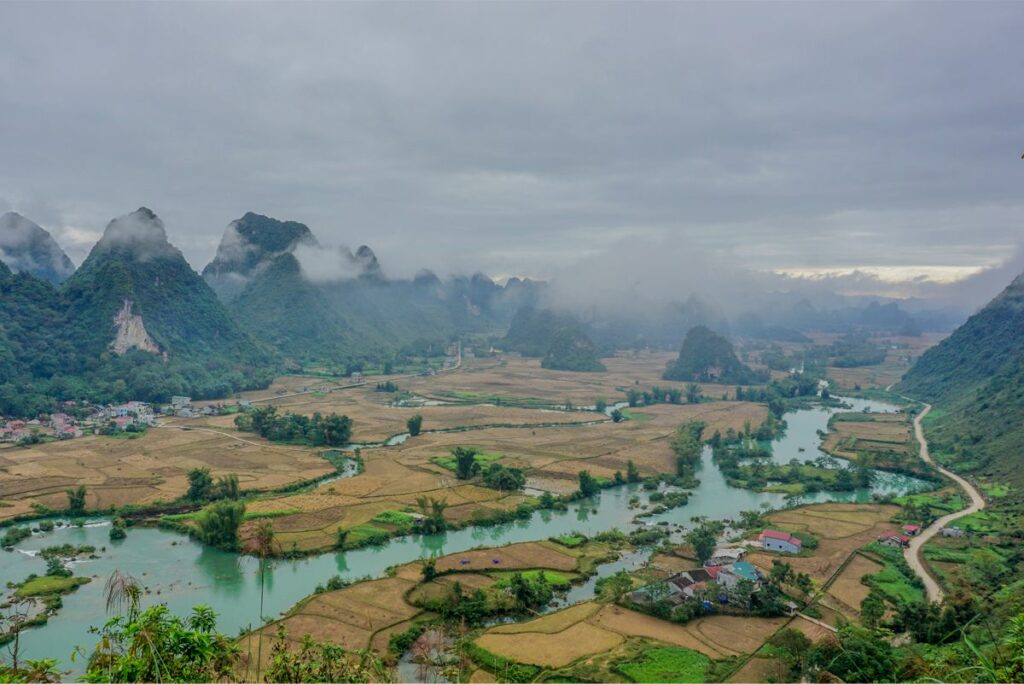
Even though the Phong Nam valley is just 10 km from the Ban Gioc waterfall, there is a very big change you will not find any tourist in this area. This hidden gem is a picturesque rural valley, surrounded by towering limestone mountains, rice fields, and small villages, offering a peaceful glimpse into traditional life in northern Vietnam.
4. Angel Eye Mountain
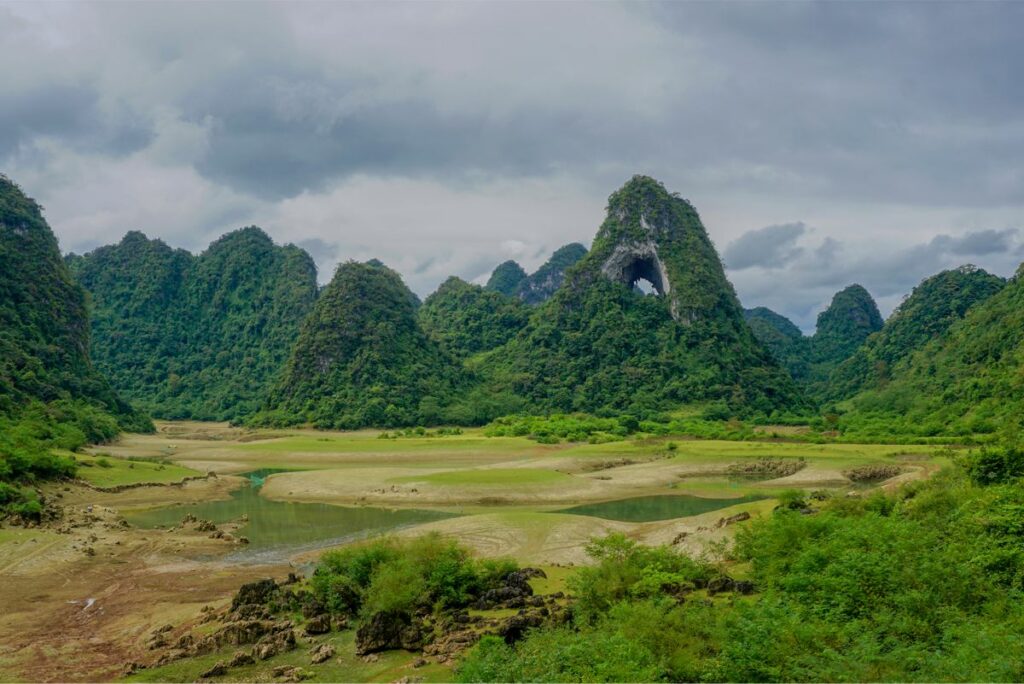
The Nui Thung mountain (60 km from Ban Gioc) is another hidden paradise hardly known by the tourist crowds. This mountain, also called Angel Eye mountain, has a huge whole in the center of the mountain. It is not only a great spot to make some photos, but the complete hidden valley is absolutely beautiful. Rich of forest, high mountain, lakes, plains and small villages of minority.
5. Thang Hen Lake
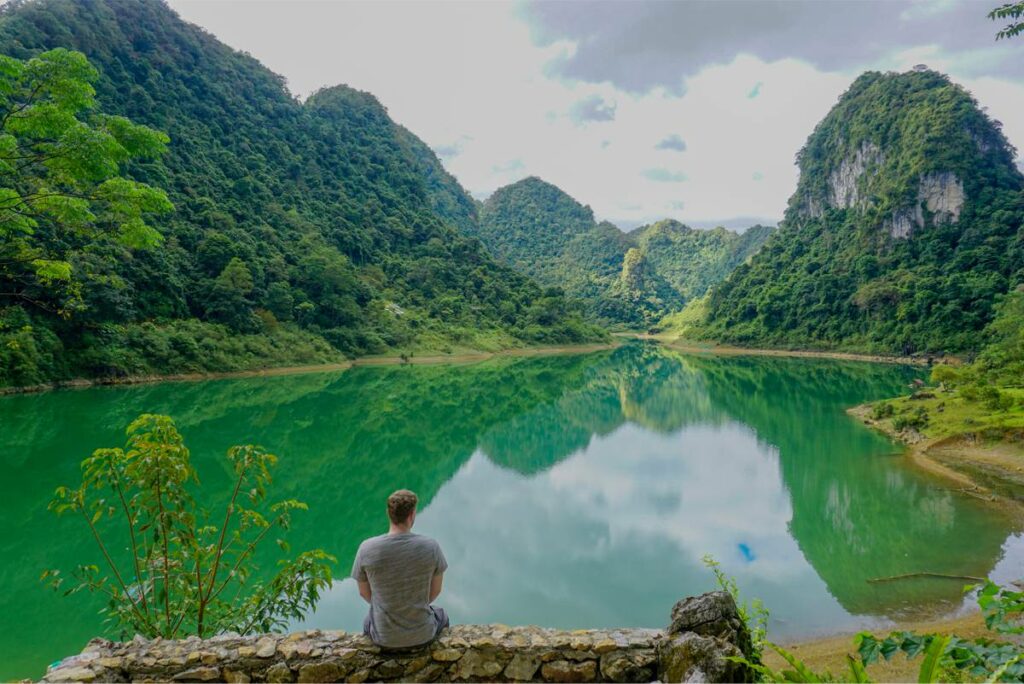
The Thang Hen Lake is right next to Nui Thung mountain. It is the biggest lake of a complete system of 36 lakes in Tinh Coc valley (Cao Bang). You can take a boat trip over the lake or relax by the water’s edge with beautiful views of the mountains that are being reflected in the lake.
How to get to the Ban Gioc Watefall
The Ban Gioc waterfall is approximately 360 kilometers from Hanoi and 90 km east of Cao Bang. You can easily reach the waterfall via a good national highway to Cao Bang city and then a number of well-maintained provincial roads that lead through fantastic scenery to the falls.
- Location of Ban Gioc (Google Maps)
Bang Gioc Waterfall tours
The easiest way to discover Bang Gioc is with a multi-day tour from Hanoi. Tours from Hanoi to Ban Gioc waterfall are often three-day trips combing visits to other local attractions in addition to the waterfall, such as Ba Be Lake and the Ngam Ngou cave.
Ba Be Lake is a natural lake in North Vietnam that is absolutely fantastic because of its amazing nature. It is located in Ba Be National Park. Although it is quite a long way from Ba Be to Ban Gioc, your journey to the northern region of Vietnam will be more complete by adding this amazing lake to the itinerary.
Tip! Check our Ban Gioc Waterfall tours. We have a few tours that are custom made and unique, combining some of the most stunning and off the beaten destinations of Cao Bang. You can visit the Ban Gioc waterfall also with Ha Giang and Ba Be Lake.
By yourself
Step 1: From Hanoi to Cao Bang
From Hanoi to Cao Bang it is fairly simple: either take a bus (sleeper buses) from the My Dinh bus station or Luong Yen bus station in Hanoi (8 hours) or ride the motorbike on Highway QL3. The highway is in good condition and runs along beautiful landscapes; from Hanoi to Cao Bang it is 280 km. The price for the bus is between the VND 190,000 – 250,000.
Also read our complete guide: From Hanoi to Ban Gioc Waterfall.
Step 2: From Cao Bang to Bang Gioc Waterfall
There are a few different ways to get from Cao Bang city to Ban Gioc Waterfall — each with its own pros and cons depending on your budget, time, and experience.
Local bus: Local buses run a few times per day between Cao Bang city and Ban Gioc, stopping at small towns along the way. It’s the cheapest option, but not always easy to navigate — ask your accommodation for the latest timetable. Keep in mind that these buses go directly to the falls without stopping at other sights along the route.
Taxi or rented car: For this distance, it’s better to arrange a car with driver for a fixed price rather than taking a metered taxi. A one-way taxi can be expensive and unreliable, especially since you won’t find taxis waiting at Ban Gioc to take you back. Booking a round-trip car in advance (with waiting time included) is a safer and more cost-effective option.
Motorbike taxi (Xe Ôm): If you’re traveling solo and on a budget, a motorbike taxi can be an option. However, it’s more worthwhile to hire a local motorbike guide instead. They’ll not only take you to the waterfall but can also stop at scenic points like Angel Eye Mountain or Phong Nam Valley and offer some local insights along the way.
Driving a Motorbike: Renting a motorbike gives you the most freedom to explore. Rentals are widely available in Cao Bang city, starting from around 180,000–250,000 VND (7–10 USD) per day. Roads are in very good condition, traffic is light, and the route is scenic. That said, the drive takes nearly 2 hours one way, so it’s not ideal as a day trip unless you’re very experienced. For safety and comfort, self-driving is best for confident riders and those who plan to stay overnight near Ban Gioc.
Where to stay near Ban Gioc Waterfall
There are several accommodation options near Ban Gioc, from local homestays to a government-run resort. Where you stay depends on your travel style — and whether you want to be right next to the waterfall or prefer a more scenic or cultural setting nearby.
1. Right at the Waterfall (Saigon–Ban Gioc Resort)
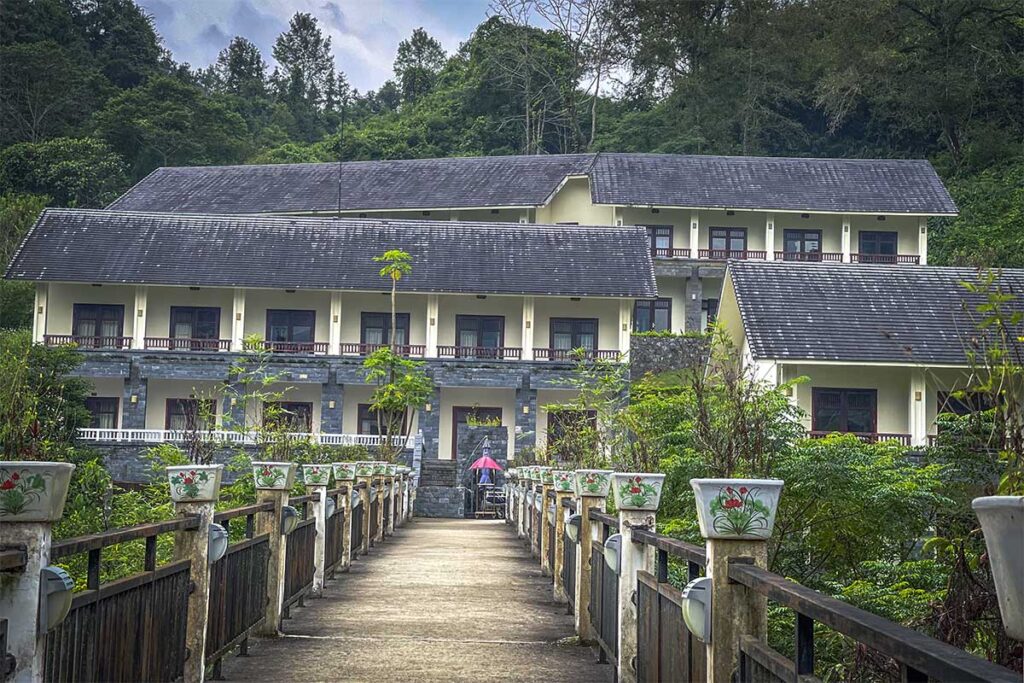
The Saigon–Ban Gioc Resort is the only hotel-style accommodation located directly across from the waterfall entrance. It’s very convenient, but the resort itself is fairly basic and feels a bit outdated. Only rooms on the top floor have partial views of the waterfall, so make sure to request one if that’s important to you. Rooms start around $40 per night.
2. Khuoi Ky Stone Village
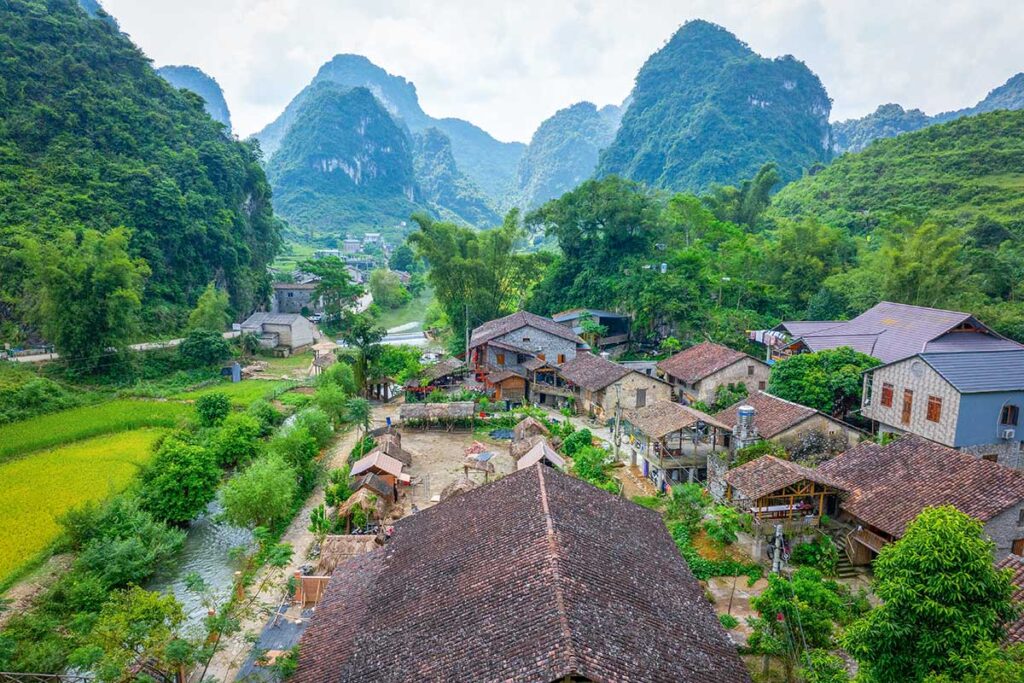
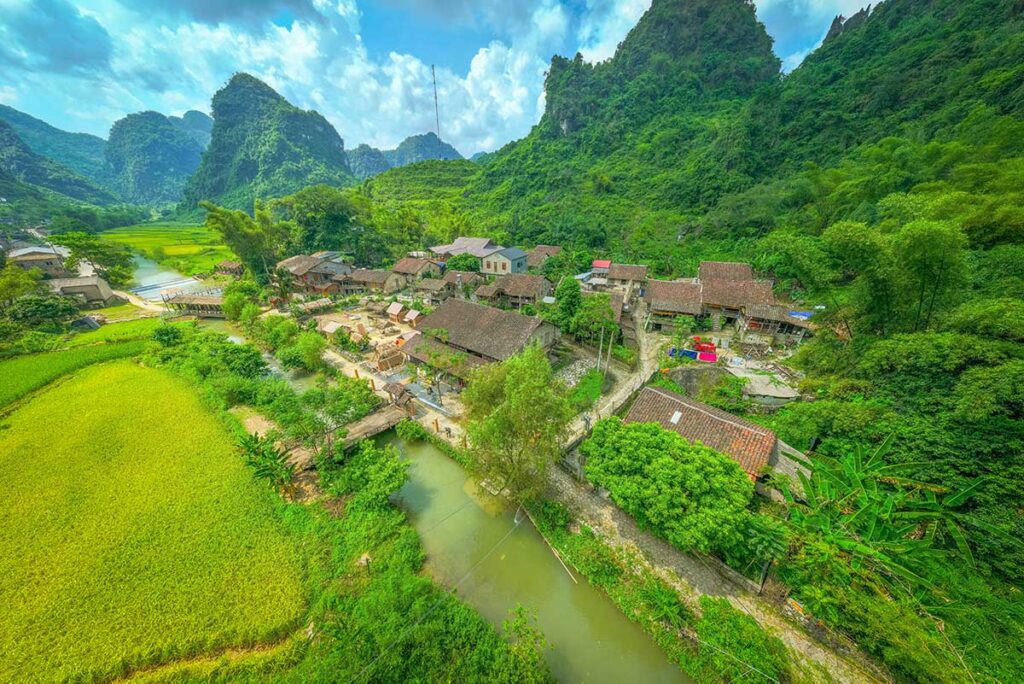
Just a few minutes from the falls, Khuoi Ky is a small ethnic village with traditional stone stilt houses, many of which have been converted into homestays. It’s a beautiful setting and quite photogenic, but the accommodations here are very basic — more about the experience than comfort. Good for those looking for something rustic and local.
3. Along the river (Lan Homestay & Others)
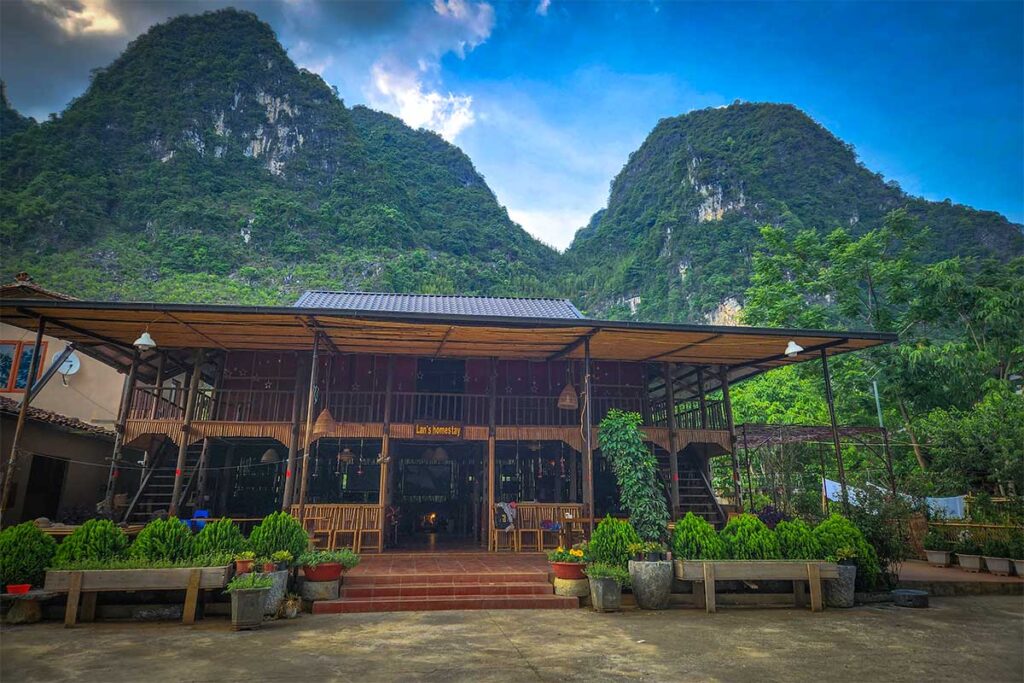
Between Nguom Ngao Cave and Ban Gioc Waterfall, you’ll find several homestays along the river and tucked between the mountains. One of the best is Lan Homestay — a peaceful, family-run stilt house set in a stunning location. It’s simple but clean, with home-cooked meals and great views. A great option if you want quiet surroundings and a local experience.
4. Cao Bang City (2 Hours Away)
Cao Bang City has by far the most accommodation options, including budget hotels and a few better mid-range stays. However, it’s a 2-hour drive each way to reach Ban Gioc, and there are many other great sights nearby, so staying closer to the waterfall is highly recommended. That said, Cao Bang is a good place to stay if you’re arriving late, catching an early bus, or need access to ATMs, shops, or better transport connections. Just don’t expect much atmosphere — the city is mostly functional.
Is Ban Gioc Waterfall worth visiting?
Yes — Ban Gioc Waterfall is absolutely worth visiting, but only if it’s part of a bigger trip.
The waterfall itself is stunning, especially in the rainy season when the flow is strong and dramatic. Even in the dry season, it’s still beautiful — though less impressive. That said, don’t make the mistake of traveling all the way from Hanoi just to see the waterfall and head back. The drive is long, and while Ban Gioc is one of Vietnam’s most photogenic natural sites, you can see it in under an hour.
What truly makes the journey worth it is everything around it. From peaceful valleys like Phong Nam, to hidden gems like Angel Eye Mountain and remote ethnic villages, Cao Bang province has so much more to offer than just one waterfall.
Planning a longer trip? See our full guide to the Best things to do in Cao Bang.
